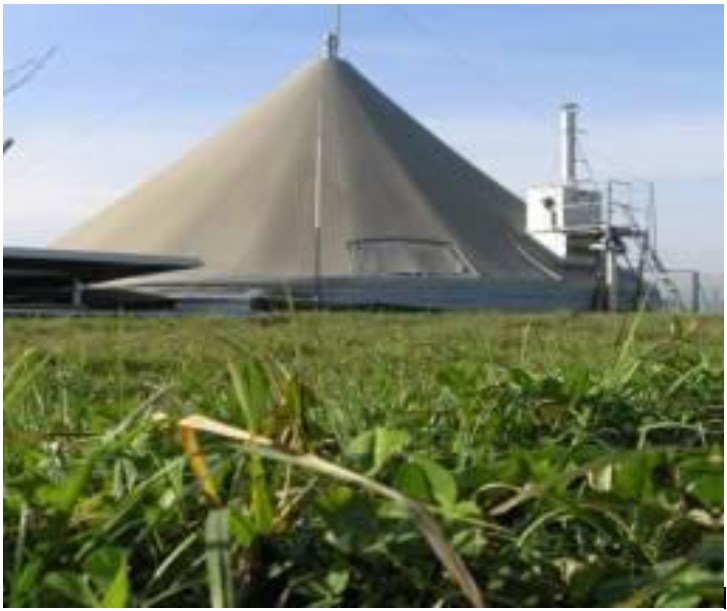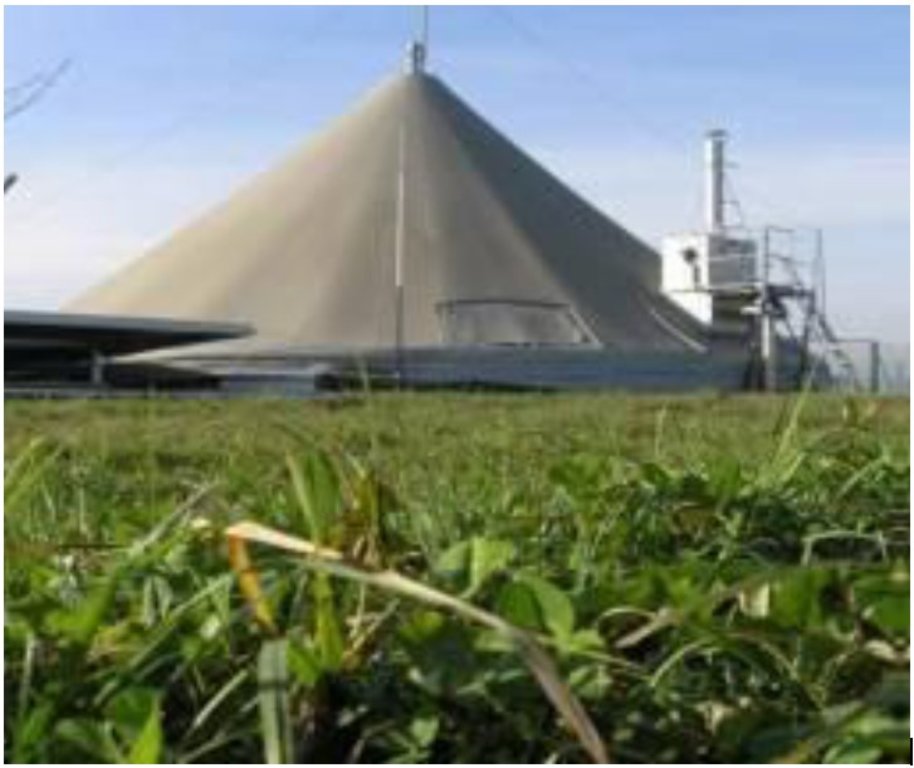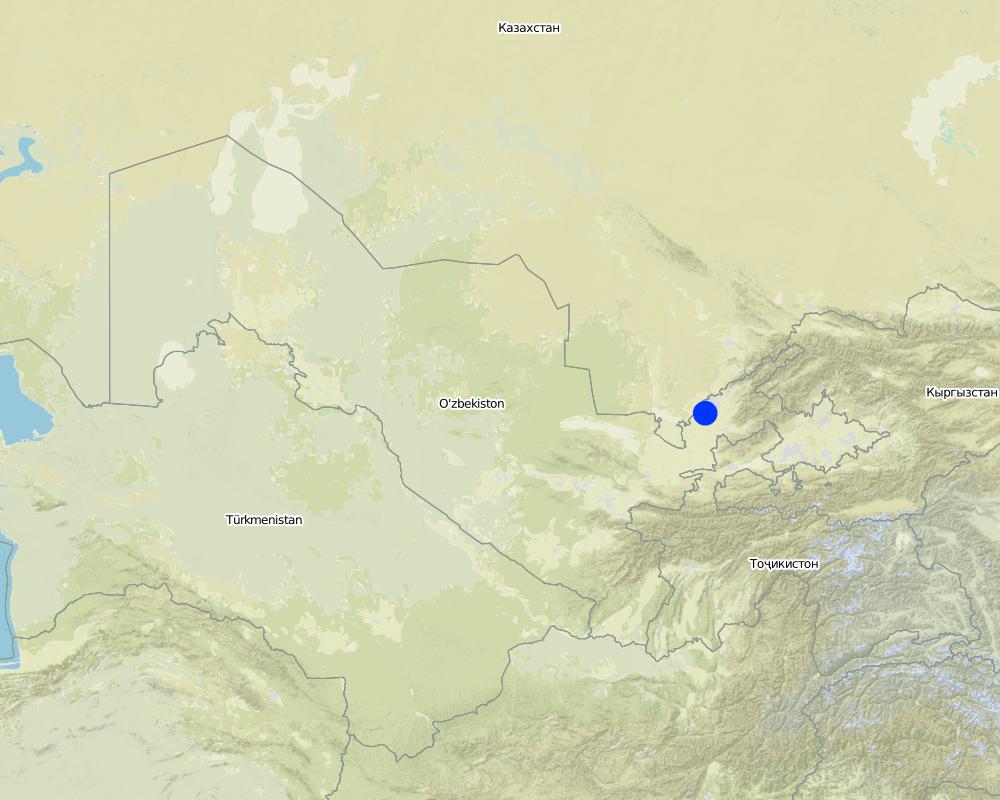Использование отходов производства биогаза для повышения плодородия почв [Uzbekistan]
- Creation:
- Update:
- Compiler: Rustam Ibragimov
- Editor: –
- Reviewers: Olga Andreeva, Elizaveta Soloveyva
Использование отходов производства биогаза для повышения плодородия почв
technologies_3645 - Uzbekistan
- Full summary as PDF
- Full summary as PDF for print
- Full summary in the browser
- Full summary (unformatted)
- Использование отходов производства биогаза для повышения плодородия почв: Nov. 7, 2018 (inactive)
- Использование отходов производства биогаза для повышения плодородия почв: Maart 18, 2019 (inactive)
- Использование отходов производства биогаза для повышения плодородия почв: Aug. 22, 2019 (inactive)
- Использование отходов производства биогаза для повышения плодородия почв: Jan. 27, 2020 (public)
View sections
Expand all Collapse all1. General information
1.2 Contact details of resource persons and institutions involved in the assessment and documentation of the Technology
Key resource person(s)
SLM specialist:
Ташкузиев Маъруф
+998712271399 / +998909975784
maruf41@rambler.ru
Государственный научно-исследовательский институт почвоведения и агрохимии
ул. Камарнисо, 3, Ташкент
Uzbekistan
land user:
Юлдашев Равшан
племенное хозяйство «Милк агро»
Зангиатинский район Ташкентской области
Uzbekistan
1.3 Conditions regarding the use of data documented through WOCAT
The compiler and key resource person(s) accept the conditions regarding the use of data documented through WOCAT:
Ja
1.4 Declaration on sustainability of the described Technology
Is the Technology described here problematic with regard to land degradation, so that it cannot be declared a sustainable land management technology?
Nee
2. Description of the SLM Technology
2.1 Short description of the Technology
Definition of the Technology:
Технология основана на использовании отходов производства биогаза в качестве высокоэффективного экологически чистого органического удобрения на полях фермеров
2.2 Detailed description of the Technology
Description:
С ростом потребностей животноводческих хозяйств в топливно-энергетических ресурсах актуальным становится вопрос их стабильного энергообеспечения, который частично можно решить внедрением технологий производства энергии из возобновляемых источников. В 2015 году Правительство Республики Узбекистан приняло постановление о стимулировании строительства биогазовых установок. По расчетам экспертов Узбекистан обладает потенциалом для производства порядка 9 млрд. м3/год биогаза, что составляет около 10% годовой потребности страны в энергоносителях (ПРООН «Дорожная карта по развитию рынка биогазовых технологий в Узбекистане», 2012). Сырьем для производства биогаза могут служить любые легко разлагаемые органические вещества - навоз, птичий помет, солома, стебли хлопчатника, листья деревьев и другие органические остатки. В последние годы в Узбекистане успешно выпол¬нены проекты ПРООН и Программы малых грантов ГЭФ по использованию биогазовых установок для автономного энергоснабжения фермерских хозяйств. В рамках Проекта ПРООН «Содействие развитию биогазовых технологий в Узбекистане» (2006) технология получения энергетических ресурсов и применения высокоэффективных органических удобрений выполнена в фермерских хозяйствах Milc-Агро и Г.Абдуллаева Зангиатинского района. Самый успешный пример производства биогаза и использования отходов в качестве органического удобрения показало фермерское хозяйство «Надежда» в Хавастском районе Сырдарьинской области. Биогазовая установка, запущенная в рамках пилотного проекта ПМГ ГЭФ (2010г.), обеспечивает электроэнергией животноводческий комплекс и ценным органическим удобрением поля под кормовыми культурами. Технология производства биогаза особенно важна для средних фермерских хозяйств в целях собственного энергообеспечения и обогащения почв гумусом. Наблюдающееся в последние десятилетия снижение содержания органического вещества почвы привело к снижению количества и качества полезных почвенных организмов из-за ухудшения их среды обитания, что стало одной из причин снижения плодородия почв. В процессе производства биогаза получается концентрированное органическое удобрение, лишенное семян сорняков и болезнетворной микрофлоры, в котором содержится в 2-4 раза больше основных питательных веществ, чем в обычных органических удобрениях, а также гуминовые кислоты, стимуляторы роста растений, витамины и аминокислоты.
Мероприятия и вклады на введение / содержание:
Продукты жизнедеятельности животных ежедневно собираются в специальных емкостях и затем отправляются в реакторы. Органические удобрения хранятся в течение семи - десяти дней при температуре 38-40 градусов, вследствие чего все бактерии и семена различных трав гибнут. Поэтому использование биоудобрений позволяет в дальнейшем снижает потребность в борьбе с сорняками на полях. Жидкие отходы, разведенные водой в пропорции 1:20 используются в качестве подкормки растений. Норма внесения 1 т/га за сезон.
Стоимость средней индивидуальной БГУ (30 м3) составляет от 15 до 18 тысяч долларов США. Срок окупаемости - от 3 до 7 лет. Чем больше БГУ, тем выше ее рентабельность и короче сроки окупаемости. Экономия за счет использования биоудобрения - 84 долл/га. Основным источником дохода от эксплуатации БГУ в фермерском хозяйстве «Надежда» является использование и продажа биоудобрения. Увеличение производства кормов на собственных угодьях позволит не только обеспечивать собственное поголовье, но и продавать излишки силоса, люцерны, кукурузы и кормовой пшеницы в среднем на сумму 1 600 долларов США в год.
2.3 Photos of the Technology
2.5 Country/ region/ locations where the Technology has been applied and which are covered by this assessment
Country:
Uzbekistan
Region/ State/ Province:
Зангиатинский район, Ташкентская область
Further specification of location:
массив Г.Абдуллаева, фермерское хозяйство Milc-Агро
Map
×2.6 Date of implementation
Indicate year of implementation:
2002
If precise year is not known, indicate approximate date:
- 10-50 years ago
2.7 Introduction of the Technology
Specify how the Technology was introduced:
- through projects/ external interventions
Comments (type of project, etc.):
Технология внедряется через проекты ПМГ ГЭФ, ПРООН
3. Classification of the SLM Technology
3.1 Main purpose(s) of the Technology
- improve production
- reduce, prevent, restore land degradation
- preserve/ improve biodiversity
- mitigate climate change and its impacts
- create beneficial economic impact
- Основные задачи – производство биогаза и биоудобрения в результате производства
3.2 Current land use type(s) where the Technology is applied

Cropland
- Annual cropping
Main crops (cash and food crops):
Хлопчатник и пшеница, кормовые культуры для животноводства
If land use has changed due to the implementation of the Technology, indicate land use before implementation of the Technology:
не изменилось
3.3 Further information about land use
Water supply for the land on which the Technology is applied:
- full irrigation
Number of growing seasons per year:
- 2
Specify:
2 урожая в год – 1 урожай хлопчатника, урожай озимой пшеницы и повторных культур (маш, фасоль и др.), посеянных после уборки пшеницы, 5-6 укосов люцерны
3.4 SLM group to which the Technology belongs
- improved ground/ vegetation cover
- integrated soil fertility management
- waste management/ waste water management
3.5 Spread of the Technology
Specify the spread of the Technology:
- evenly spread over an area
If the Technology is evenly spread over an area, indicate approximate area covered:
- < 0.1 km2 (10 ha)
Comments:
в исследованных хозяйствах Milk-Agro и «Надежда» технология применяется на площади 10 га и 13 га
3.6 SLM measures comprising the Technology

agronomic measures
- A1: Vegetation/ soil cover
- A2: Organic matter/ soil fertility
3.7 Main types of land degradation addressed by the Technology

chemical soil deterioration
- Cn: fertility decline and reduced organic matter content (not caused by erosion)

physical soil deterioration

biological degradation
- Bl: loss of soil life
Comments:
Низкие нормы органических удобрений и уборка с полей растительных остатков способствовали снижению содержания гумуса и ухудшению среды обитания полезных почвенных организмов, что привело к снижению количества и качества почвенной макро- и микрофауны. От содержания гумуса зависит интенсивность биохимических процессов, обусловливающих накопление питательных веществ, необходимых растениям.
3.8 Prevention, reduction, or restoration of land degradation
Specify the goal of the Technology with regard to land degradation:
- reduce land degradation
Comments:
Использование отходов производства биогаза способствует повышению органического вещества, улучшению среды обитания полезных почвенных организмов, формирует структуру почвы.
4. Technical specifications, implementation activities, inputs, and costs
4.1 Technical drawing of the Technology
Author:
https://econet.ru/articles/146539-kak-poluchit-biogaz-iz-navoza-tehnologiya-i-ustroystvo-ustanovki-po-proizvodstvu
4.2 Technical specifications/ explanations of technical drawing
Схема иллюстрирует биогазовый комплекс для производства биогаза и биоудобрений
4.3 General information regarding the calculation of inputs and costs
Specify how costs and inputs were calculated:
- per Technology area
Indicate size and area unit:
1 гектар
Indicate exchange rate from USD to local currency (if relevant): 1 USD =:
3500.0
Indicate average wage cost of hired labour per day:
около 4 долл. США
4.4 Establishment activities
| Activity | Type of measure | Timing | |
|---|---|---|---|
| 1. | Приобретение и монтаж биогазовой установки | Structural | Теплое время года |
| 2. | Уход за посевами (культивация с внесением удобрений, поливы) | Agronomic | июль-октябрь |
| 3. | Уборка урожая | Agronomic | ноябрь |
| 4. | Запашка растительных остатков | Agronomic | ноябрь |
| 5. | Боронование-малование и посев сидерата | Agronomic | ноябрь |
| 6. | Запашка сидерата | Agronomic | апрель |
4.5 Costs and inputs needed for establishment
| Specify input | Unit | Quantity | Costs per Unit | Total costs per input | % of costs borne by land users | |
|---|---|---|---|---|---|---|
| Equipment | Закупка и монтаж БГУ | шт. | 1.0 | 18000.0 | 18000.0 | 30.0 |
| Total costs for establishment of the Technology | 18000.0 | |||||
If land user bore less than 100% of costs, indicate who covered the remaining costs:
проект
4.6 Maintenance/ recurrent activities
| Activity | Type of measure | Timing/ frequency | |
|---|---|---|---|
| 1. | Транспортировка и внесение удобрения | Agronomic | 2-3 раза в течение вегетации для подкормки растений |
Comments:
Вклады в поддержание технологии относятся только к транспортировке биоудобрения до поля.
4.7 Costs and inputs needed for maintenance/ recurrent activities (per year)
| Specify input | Unit | Quantity | Costs per Unit | Total costs per input | % of costs borne by land users | |
|---|---|---|---|---|---|---|
| Labour | Транспортировка и внесение удобрения | долл. США/га | 100.0 |
If land user bore less than 100% of costs, indicate who covered the remaining costs:
Затраты относятся только к транспортировке удобрения к полю
4.8 Most important factors affecting the costs
Describe the most determinate factors affecting the costs:
Наибольшие затраты относятся к приобретению и монтажу биогазовой установки
5. Natural and human environment
5.1 Climate
Annual rainfall
- < 250 mm
- 251-500 mm
- 501-750 mm
- 751-1,000 mm
- 1,001-1,500 mm
- 1,501-2,000 mm
- 2,001-3,000 mm
- 3,001-4,000 mm
- > 4,000 mm
Specify average annual rainfall (if known), in mm:
418.00
Specifications/ comments on rainfall:
96% осадков приходится на октябрь-май
Indicate the name of the reference meteorological station considered:
Ташкент
Agro-climatic zone
- semi-arid
Продолжительность вегетационного периода составляет 160 дней
5.2 Topography
Slopes on average:
- flat (0-2%)
- gentle (3-5%)
- moderate (6-10%)
- rolling (11-15%)
- hilly (16-30%)
- steep (31-60%)
- very steep (>60%)
Landforms:
- plateau/plains
- ridges
- mountain slopes
- hill slopes
- footslopes
- valley floors
Altitudinal zone:
- 0-100 m a.s.l.
- 101-500 m a.s.l.
- 501-1,000 m a.s.l.
- 1,001-1,500 m a.s.l.
- 1,501-2,000 m a.s.l.
- 2,001-2,500 m a.s.l.
- 2,501-3,000 m a.s.l.
- 3,001-4,000 m a.s.l.
- > 4,000 m a.s.l.
Comments and further specifications on topography:
450 м н.у.м.(Milc-Agro) и 273 м н.у.м. (Хаваст)
5.3 Soils
Soil depth on average:
- very shallow (0-20 cm)
- shallow (21-50 cm)
- moderately deep (51-80 cm)
- deep (81-120 cm)
- very deep (> 120 cm)
Soil texture (topsoil):
- medium (loamy, silty)
Soil texture (> 20 cm below surface):
- medium (loamy, silty)
Topsoil organic matter:
- low (<1%)
If available, attach full soil description or specify the available information, e.g. soil type, soil PH/ acidity, Cation Exchange Capacity, nitrogen, salinity etc.
Почвы лугово-сероземные, засоленные и промытые на суглинисто-супесчаном аллювии и пролювии (Calcisol, sulphatic). Содержание гумуса в пахотном слое меньше 1%.
5.4 Water availability and quality
Ground water table:
< 5 m
Availability of surface water:
good
Water quality (untreated):
good drinking water
Is water salinity a problem?
Nee
Comments and further specifications on water quality and quantity:
Вода в поверхностных источниках загрязняется от сбросов дренажного стока с полей орошения
5.5 Biodiversity
Species diversity:
- medium
Habitat diversity:
- medium
Comments and further specifications on biodiversity:
на орошаемой территории растительность представлена культурными видами растений, которые выращивают на полях: хлопчатник, пшеница, овощные, бахчевые, многолетние насаждения фруктовые и декоративные деревья и кустарники
5.6 Characteristics of land users applying the Technology
Sedentary or nomadic:
- Sedentary
Market orientation of production system:
- mixed (subsistence/ commercial
Off-farm income:
- 10-50% of all income
Relative level of wealth:
- average
Individuals or groups:
- individual/ household
Level of mechanization:
- mechanized/ motorized
Gender:
- men
Age of land users:
- middle-aged
5.7 Average area of land owned or leased by land users applying the Technology
- < 0.5 ha
- 0.5-1 ha
- 1-2 ha
- 2-5 ha
- 5-15 ha
- 15-50 ha
- 50-100 ha
- 100-500 ha
- 500-1,000 ha
- 1,000-10,000 ha
- > 10,000 ha
Is this considered small-, medium- or large-scale (referring to local context)?
- medium-scale
Comments:
Средний размер фермерских хозяйств составляет 35-75 га, дехканских и приусадебных участков – до 0,35 га
5.8 Land ownership, land use rights, and water use rights
Land ownership:
- state
- individual, titled
Land use rights:
- leased
- Через Ассоциации водопользователей и и управления оросительных систем
5.9 Access to services and infrastructure
health:
- poor
- moderate
- good
education:
- poor
- moderate
- good
technical assistance:
- poor
- moderate
- good
employment (e.g. off-farm):
- poor
- moderate
- good
markets:
- poor
- moderate
- good
energy:
- poor
- moderate
- good
roads and transport:
- poor
- moderate
- good
drinking water and sanitation:
- poor
- moderate
- good
financial services:
- poor
- moderate
- good
6. Impacts and concluding statements
6.1 On-site impacts the Technology has shown
Socio-economic impacts
Production
crop production
energy generation
Income and costs
expenses on agricultural inputs
farm income
workload
Ecological impacts
Biodiversity: vegetation, animals
Vegetation cover
Climate and disaster risk reduction
emission of carbon and greenhouse gases
6.2 Off-site impacts the Technology has shown
Comments regarding impact assessment:
технология не оказывает отрицательного влияния на окружающую территорию за пределами территории ее применения
6.3 Exposure and sensitivity of the Technology to gradual climate change and climate-related extremes/ disasters (as perceived by land users)
Gradual climate change
Gradual climate change
| Season | Type of climatic change/ extreme | How does the Technology cope with it? | |
|---|---|---|---|
| annual temperature | increase | well | |
| seasonal temperature | summer | increase | well |
| annual rainfall | decrease | well | |
| seasonal rainfall | spring | decrease | well |
| seasonal rainfall | summer | decrease | well |
Climate-related extremes (disasters)
Climatological disasters
| How does the Technology cope with it? | |
|---|---|
| heatwave | well |
| drought | well |
Comments:
Технология не зависит от климата, а только от количества животных, производящих сырье для производства биогаза
6.4 Cost-benefit analysis
How do the benefits compare with the establishment costs (from land users’ perspective)?
Short-term returns:
negative
Long-term returns:
very positive
How do the benefits compare with the maintenance/ recurrent costs (from land users' perspective)?
Short-term returns:
negative
Long-term returns:
very positive
Comments:
Срок окупаемости более 3 лет, поэтому в краткосрочной перспективе землепользователь без внешней поддержки несет убытки
6.5 Adoption of the Technology
- 10-50%
Of all those who have adopted the Technology, how many have did so spontaneously, i.e. without receiving any material incentives/ payments?
- 10-50%
6.6 Adaptation
Has the Technology been modified recently to adapt to changing conditions?
Nee
6.7 Strengths/ advantages/ opportunities of the Technology
| Strengths/ advantages/ opportunities in the land user’s view |
|---|
| Самообеспечение энергией |
| Двойная выгода – биогаз и удобрение |
6.8 Weaknesses/ disadvantages/ risks of the Technology and ways of overcoming them
| Weaknesses/ disadvantages/ risks in the land user’s view | How can they be overcome? |
|---|---|
| Высокая стоимость | Кредитование |
7. References and links
7.1 Methods/ sources of information
- field visits, field surveys
Июль-ноябрь 2016-2017г.г., 2013
- interviews with land users
опрошено 3 чел
- interviews with SLM specialists/ experts
3 чел
- compilation from reports and other existing documentation
7.3 Links to relevant information which is available online
Title/ description:
С. Шоева ДЕШЕВАЯ И КАЧЕСТВЕННАЯ ЭНЕРГИЯ ИЗ МЕСТНОГО СЫРЬЯ. 2009 г.
URL:
http://www.cawater-info.net/news/04-2009/03.htm
Title/ description:
И.В. Дергачева, П.Т. Салихов. Биогаз, электроэнергия, тепло. 11 шагов к цели Практическое руководство Ташкент, 2011
URL:
https://mineconomy.uz/sites/default/files/pictures/biogaz1.pdf
Title/ description:
Л.В. Завьялова, П.Т. Салихов. ПРООН. ДОРОЖНАЯ КАРТА по развитию рынка биогазовых технологий в Узбекистане
URL:
https://mineconomy.uz/sites/default/files/pictures/biogaz3.pdf
Title/ description:
Л.В. Завьялова, И.В. Дергачева ПРООН. Использование БИОГАЗА для автономного энергообеспечения фермы. ИСТОРИЯ УСПЕХА
URL:
https://mineconomy.uz/sites/default/files/pictures/biogaz2.pdf
Links and modules
Expand all Collapse allLinks
No links
Modules
No modules





